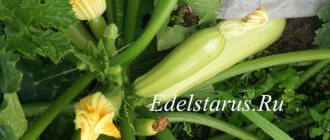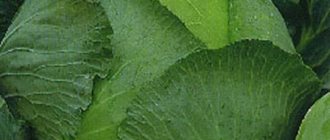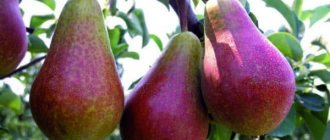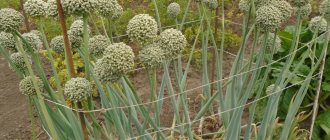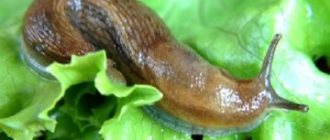Author's rating
Author of the article
Yakov Pavlovich
Professor, Head of the Department of Vegetable Growing
Articles written
153
Pineapple melons are becoming increasingly popular. The reason for this is the interesting taste. One cannot help but mention the possibility of growing a crop independently on your own plot, so as not to wait for it to appear on the shelves. Next, we will consider the features of agricultural technology, the advantages of the hybrid and the subtleties that will help grow pineapple melon.
Features of culture and beneficial properties
The fruits of the crop are characterized by an oval shape. The skin is thin, with a yellow-orange tint. The melon is dotted with a three-dimensional mesh. The weight of a ripe fruit is 1-2.5 kg. The area under the skin has a yellow or orange tint, and towards the edges it turns green. The pulp is tender, juicy and slightly oily. The hybrid has excellent taste and is distinguished by a light pineapple aroma.
Melon is beneficial for the human body. The fruit is used for ailments such as anemia, anemia, tuberculosis, gout, and rheumatism. It is also recommended to take the culture for problems with the respiratory tract, gastrointestinal tract and cardiovascular system.
Choosing the right neighbors is the key to melon health
A preventive measure that protects melons from diseases and pests is choosing the right neighbors. They protect marigold plantings near melon beds from aphids. It is also suitable to plant beds with garlic, green onions, dill and other herbs.
- Regular weeding is very important in the fight against fungal diseases. Avoid stagnation of water. Be sure to carry out loosening.
- Drug treatment consists of spraying plants with Bordeaux mixture or pollination with sulfur powder. Treatment is carried out at intervals of 10–15 days, up to 4 times per season.
- To combat powdery mildew, the drug “Topaz” or “Oxychom” is used.
- It is customary to combat fusarium with potassium chloride by spraying during the budding period.
Proper seed preparation plays an important role in the fight against diseases. In particular, they are kept in a solution of potassium permanganate. For this purpose, stratification is used, as well as keeping seeds in hot water up to 45 degrees. The latter improves seed germination and subsequently disease resistance.
The best varieties and hybrids of pineapple melon
Pineapple melons are similar in properties, but there are several varieties of the crop. The most popular are:
- GOLD is a mid-season hybrid. Characterized by lumpy skin with a green tint. The pulp takes on different colors: from yellow to red. The taste of melon is sweet, sometimes cloying. There is a distinct smell of pineapple;
- Sweet pineapple F1 - refers to early ripening hybrids. They are erected in open ground and greenhouses. The fruits are small in size, the weight of one melon reaches 2 kg. Round shape. The peel is rough and has a green or brown mesh on the surface. The pulp is light yellow or orange. The taste of the hybrid is delicate, there is the taste and aroma of pineapple;
- American pineapple is a mid-season variety. They are erected in open ground. The hybrid is characterized by high yield and resistance to sub-zero temperatures. The fruits are round in shape and weigh 2.5 kg. The skin color is beige or light green. The pulp tastes like pineapple.
- Americano hybrid is classified as super-ripe. Melons grow small, the weight of one fruit is 400 g. The peel has a yellow tint and pronounced brown stripes. The inside of the melon is soft, juicy and has a subtle pineapple flavor.
See also Rules for the formation of melons in open ground: rules for pinching and pinching
Summing up
American melon Pineapple is a hybrid variety that has gained immense popularity among gardeners and amateur gardeners. They are attracted not only by the unique taste qualities, but also by the variety’s yield and unpretentiousness. They grow tasty, aromatic fruits in their garden, following simple rules for caring for the plant. High-quality seed material and compliance with planting rules are already the key to a good harvest.
Among the variety of varieties and hybrids of melon for growing, it is difficult for an inexperienced gardener to choose. Pineapple melon is one of the mini-melons that many prefer primarily for its unique taste and aroma. Melon of the Pineapple variety really has the taste of pineapple and, in addition, has a number of properties necessary for the convenient use of agricultural methods.
Today, the Pineapple variety has many subspecies and hybrids. Some of them were obtained by crossing with another variety of this crop - the Temryuchanka variety. Pineapple melon is adapted to growing in warm regions. This variety has low frost resistance. In general, the variety belongs to the mid-season varieties - the harvest can be harvested within 65 days after planting.
All varieties are united by the rich taste of pineapple; the fruits are elongated, oval in shape, and weigh up to three kilograms. Some varieties are quite hardy to unfavorable environmental conditions. All hybrids are characterized by a high degree of immunity to the causative agents of multiple diseases of this crop - late blight, coletotrichium and podosphere, which causes powdery mildew.
Specifics of cultivation
The hybrid can be grown in the southern regions by direct sowing of seeds into the soil. Regions with cold climatic conditions are suitable for planting the variety in seedlings.
Choosing a location taking into account crop rotation
Pineapple melon is an unpretentious plant. It is erected on any soil, but a high yield can be obtained by planting plants on neutral soil. Choose a place that is sunny and free from drafts.
The optimal predecessors for the crop will be: cabbage, onions, turnips, corn, greens (except parsley), legumes, beets. A minimum of nutrients will remain for the melon if the plant is planted after cucumbers or pumpkins.
Timing of sowing scheme
Planting of pineapple melon begins depending on climatic conditions. The approximate period for sowing seeds is the end of spring - the third part of May. It is also necessary to focus on how the earth has warmed up. The soil temperature must be at least +15°C.
Expert opinion
Stanislav Pavlovich
Gardener with 17 years of experience and our expert
Ask a Question
Attention! Active growth of the crop is observed at a temperature of +25-30°C.
Seeds are not planted deeply. The maximum depth is 15-20 mm. You can speed up growth by covering the holes with polyethylene. The film must be removed when the first shoots appear.
Melon is planted at intervals of 80-100 cm from each other, since the crop is prone to active growth.
Conditions for growing seedlings
Before sowing, experienced gardeners recommend soaking the seeds. To do this, planting material is placed in warm water for several days. The fluid is changed daily. From the moment they hatch, the seeds are ready to be planted in the soil.
Strictly one seed is placed in one container. To create a greenhouse effect, each cup is covered with film. The container with seedlings is placed in a lighted place. To prevent the seedlings from stretching, the cups are regularly turned over.
After 30 days, the plants are ready for planting in open soil. Before this, melons must be hardened. To do this, glasses with seedlings are taken out into the open air every day.
Melon: benefits, calorie content, glycemic index
The tender, aromatic melon pulp is filled with vitamins (A, C, E, B1, B2, B5, B6, B9, PP) and microelements (sodium, potassium, calcium, manganese, copper, magnesium). The juicy fruit is also valued for its low calorie content - 30-38 g (depending on the variety). A melon dessert is unlikely to harm your figure. However, there is another parameter - the rate at which the melon is absorbed by the body. According to this criterion, melon loses to other agricultural crops. The sugar contained in the pulp is quickly absorbed by the body. This leads to a sharp increase in blood glucose levels. Therefore, people who monitor their sugar levels need to know that the glycemic index of melon tends to be high and is 65 units. You can learn more about the benefits of melon here.
Further care
Proper care of the crop is a guarantee of a healthy harvest.
Watering the beds
Pineapple melon needs to be watered constantly. The liquid consumption is 500 ml per plant. Over time, the volume is increased to 3 liters.
Watering is reduced at the flowering stage of the crop. At this time, the beds are moistened once every 5 days. During the period of fruit ripening, irrigation is further reduced. About a week before harvest, the beds completely stop being watered.
What and how to feed pineapple melon
For convenience, watering is combined with fertilizing. Fertilizers are applied according to the following scheme:
- 14 days after placing the seedlings in open ground: 2 liters of nutrient mixture are sent to each plant (20 g of ammonium nitrate per 10 liters of liquid);
- at the budding stage: feeding with mullein or ammonia solution;
- 14-21 days after the last feeding they resort to mineral fertilizers.
Soil care
To prevent stagnation of liquid and for better oxygen supply to the root system, the soil in the beds should be loosened regularly. At first, the procedure is carried out every week, then less often. As soon as the crop begins to form lateral stepsons, the melon is hilled up. Weeds are also systematically removed.
Protection from pests and diseases
Pineapple melon is susceptible to diseases characteristic of other melon crops. In particular, we are talking about spider mites, cutworms, wireworms, aphids, etc. The plant is also susceptible to diseases such as downy mildew, fusarium, and copperhead.
See also Melon Torpedo: benefits and harm for men's and women's health
In order to protect crops from diseases and pests, various methods are used. One of the most popular is the placement of eggshells and onion peels in the holes before planting. Also, for prevention purposes, the crop is sprayed with solutions based on soap, garlic or onions. The planting can be protected by planting marigolds or other plants with a distinct aroma near the melon.
What it is?
This amazing plant has African roots, but it can increasingly be found among Russian gardeners and gardeners. Due to its very unique appearance and some similarity with the crops familiar to our consumers, Kiwano is called horned melon and even African cucumber. Such analogies are due to the presence of peculiar spikes on the surface of the fruit, as well as in light of the oval shape of the fruit.
From the point of view of its belonging to any plant species, it belongs to the herbaceous vines of the Pumpkin family. The peel is yellow-orange in color, with a jelly-like pulp containing a large number of seeds. Judging by the reviews, the taste of kiwano is quite tart, and the peel is rarely used for food. The degree of ripeness of the fruit is indicated by the richness of the color of the fruit - ripe fruit becomes bright orange.
As a rule, an adult plant reaches a height of about 5 meters, although due to its ability to curl it has a very decorative appearance. That is why kiwano often acts as an element with which you can originally design a personal plot or even a loggia. The crop is very hardy, it is resistant to various diseases, in addition, competent agricultural technology allows you to get a fairly decent fruit harvest.
Despite the fact that the origin of kiwano is African, today there are many varieties of this plant that are recommended for cultivation in a particular region and climate. Some varieties are intended for cultivation in Siberia under greenhouse conditions. In a favorable climate, growing horned melon in open ground can be quite successfully grown in the central regions of Russia.
The fruit is low in calories. One fruit contains about 44 calories. In terms of nutritional balance, kiwano contains the following:
- carbohydrates – 7.6 grams;
- proteins – no more than 1.8 grams;
- fats – 1.3 grams.
There is a domestic variety of vine called “Green Dragon”. The crop is annual, its growing season is about 80 days. The height of the stems is usually three meters. Ripe fruits weigh 150 grams and can be stored for at least six months after picking. But still, the main suppliers of the fruit are the countries of Africa, Israel and South America.
The liana blooms with small but numerous yellow flowers. The climbing plant has a superficial root system. The foliage is similar to cucumber green mass, but differs from it in smaller size.
The fruit is low in calories. One fruit contains about 44 calories. In terms of nutritional balance, kiwano contains the following:
- carbohydrates – 7.6 grams;
- proteins – no more than 1.8 grams;
- fats – 1.3 grams.
Regarding the daily norm for the body, it is worth noting that 100 grams of fruit accounts for about 2% of the necessary substances. As for purchasing exotic fruit, in this matter you should rely on the following recommendations:
- the fruit should not have visual damage, in addition, preference should be given to medium-sized kiwanos;
- bright color will indicate that it is ripe;
- the fruit should be elastic to the touch;
- In addition, a ripe kiwano should have yellow thorns.
If the fruits are intended to be transported somewhere, it is better to opt for unripe products. A distinctive feature of the fruit is its ability to ripen after being picked. There are a number of recommendations regarding storing fruit at home; in many ways, the requirements are similar to the conditions necessary for storing cucumbers. Like most fruits, kiwano is best stored in a special lower compartment in the refrigerator. In order for the fruit to ripen, you need to leave it in the sun.
Signs of ripeness and harvest rules
You can start harvesting only after making sure that the pineapple melon is completely ripe. First of all, pay attention to the shade of the fruit or the mesh with which they are covered. Ripe specimens easily lag behind the vines and are distinguished by a specific shade. The mesh on the peel spreads evenly around the entire perimeter of the fruit. However, it is worth noting that such melons cannot be stored for a long time. The maximum time they will last is only 1.5 months.
If the gardener plans to store the crop for a long time, you need to pick melons from the beds with a medium mesh that does not cover the entire fruit.
Harvesting is carried out in the morning (before the heat sets in) or in the evening. The picked melons are not collected from the ground for several days, turning over every 6 hours. Afterwards they can be stored in a cool, dry place.
Expert opinion
Stanislav Pavlovich
Gardener with 17 years of experience and our expert
Ask a Question
Attention! Melons that are supposed to be stored for a long time are picked so that a tail of at least 3 cm remains.
Choosing a pomegranate
Pomegranate contains many vitamins, for example C, P, group B, a lot of valuable organic acids, macro- and microelements: magnesium, silicon, calcium. The juice of this product is very useful for anemia. It is imperative to consume pomegranate during the recovery period after operations or infectious diseases.
Since it is not cheap, it is important to be able to choose a ripe and tasty fruit
The signs of a quality pomegranate are simple. Its skin is shiny, bright, without dents or stains. There should be a few dried, hard petals left where the flower was. By pressing on a ripe fruit, you can feel how the grains crunch and shift. If you come across an attractive-looking pomegranate, but with a dent or crack, do not be tempted, put it back - the juice in the grains has probably already turned sour and fermented.
Useful tips from experienced gardeners
In general, there should be no problems with growing hybrids, since during the breeding period the varieties concentrated the positive qualities of the crop as much as possible. However, there are several subtleties, if observed, you can be guaranteed a high yield.
First of all, experienced gardeners recommend choosing planting material wisely. Preference is given not only to proven varieties, but also to the place where the seeds are purchased. It is better to pay attention to trusted manufacturers. The envelope with seeds must contain complete information about the product. It is better to buy planting material in specialized stores.
If you want to prepare the seeds yourself, then at least three years must pass before planting.
Possible pests
Melon crops are susceptible to insect attacks, but rarely suffer from other causes. The gardener needs to pay attention to mites and whiteflies. Traditional recipes will help you overcome pests. To protect the hybrid from insects, you need to make a solution of ash or whey using laundry soap, which repel pests. If the melon is attacked by insects, and folk remedies do not help, it is necessary to resort to the help of insecticides.

